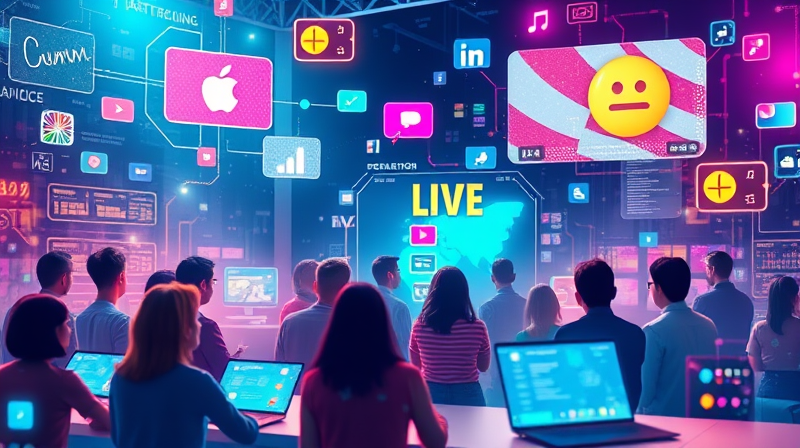Online shows and live streams have revolutionized the way creators and audiences interact, and the ever-changing digital landscape demands a hands-on, strategic approach. As we move further into the era of interactive broadcasting, it is essential to embrace both the technological and creative elements to captivate viewers. The future of streaming is not just about transmitting content, but about building connections, creating vibrant communities, and harnessing innovative tools to make every live moment memorable.
Embrace the spirit of interactivity by inviting your audience into a two-way conversation. Modern viewers no longer settle for passive experiences; they crave opportunities to influence the flow of the show. Employing real-time polls, engaging in Q&A sessions, and integrating live chats transforms the broadcast into a lively forum where everyone feels included.
Strategies to Enhance Engagement
Successful streamers make a concerted effort to blend fun and functionality through a variety of interactive tactics. One strategy is to use real-time voting, which allows viewers to decide on topics or even help shape the direction of the content. This not only makes the stream more engaging but also gives the audience a sense of ownership.
Another technique is utilizing a dedicated Q&A segment where questions are addressed live, interspersed with direct comments from viewers. This personal touch transforms an ordinary stream into a platform for shared experiences and learning.
- Real-Time Polls and Votes: Leverage polls to let your audience decide on various facets of the show.
- Live Chat Integration: Forge a strong connection by interacting with your audience in real time.
- Gamification Elements: Introduce quizzes and interactive challenges that reward active participation.
Investing in technology is equally important. A high-quality stream depends on both the visual and auditory experience. Tools such as professional cameras, refined microphones, and enhanced lighting systems contribute greatly to the overall feel of the stream. Streaming software like Streamlabs OBS and other overlay tools further refine the viewing experience by adding interactive elements and smooth transitions.
Moreover, integrating AI can provide a polished, professional experience by offering personalized notifications and efficient moderation. This use of modern technology not only elevates the aesthetic appeal but also ensures that the stream is seamless, secure, and well-managed.
The benefits of these technological investments extend far beyond the immediate broadcast. They help to build trust and authority among your audience, making them more likely to return for future streams and recommend your content to others.
Cultivating a Loyal Community
One of the greatest advantages of live streaming is the ability to build a dedicated community. Even after the stream ends, the engagement doesn’t have to stop. Social media platforms such as Instagram, TikTok, and YouTube provide excellent avenues to disseminate highlights, share moments from behind the scenes, and keep the conversation going.
Creating dedicated spaces such as Discord servers or online forums allows fans to interact, share experiences, and stay updated on upcoming events. This type of community building not only strengthens the bond between the creator and their audience but also leads to organic growth of your follower base.
- Social Media Networking: Share captivating snippets and highlights on various platforms.
- Community Hubs: Use platforms like Discord to create a central meeting place for fans.
- Collaborations: Work with other creators to bring fresh perspectives and expand your reach.
Planning and strategic scheduling are indispensable components of successful streaming. Analyzing viewer metrics such as peak activity times and engagement rates can lead to timely broadcasts that capture the highest possible audience. Announcing schedules in advance and diversifying the format of your content—whether it be tutorials, Q&A sessions, or in-depth panel discussions—helps keep your audience excited and engaged.
Every successful streamer understands that consistency is key. Regular streaming builds anticipation and establishes a routine for viewers, fostering a deeper connection with the content creator. Incorporating variability in content ensures that every broadcast offers something new and exciting, thereby reducing the risk of viewer fatigue.
Staying Ahead with Emerging Trends
As technology evolves, so do the methods available to creators. Live shopping is emerging as a powerful tool that seamlessly integrates commerce with entertainment. Platforms are now enabling viewers to make instant purchases during a live stream, blending immediate gratification with the excitement of participation.
Additionally, the exploration of decentralized streaming platforms, driven by Web3 and blockchain technologies, presents unique opportunities for content monetization and ownership. These innovations empower creators to maintain greater control over their content and revenue streams while providing an enhanced viewing experience.
Lastly, improving accessibility through captions and subtitles makes your streams inclusive. This not only broadens your audience base but also demonstrates a commitment to diversity, ensuring that all viewers feel welcome.
In conclusion, engaging with online shows and streams in today's dynamic environment requires a blend of innovation, strategic planning, and a dedication to community building. By embracing interactive tools, investing in quality technology, and remaining agile in your streaming approach, you can create experiences that resonate long after the camera stops rolling. Take these guidelines to heart and step into the world of interactive streaming with confidence and creativity, knowing that the future is bright for those who dare to connect and innovate.








